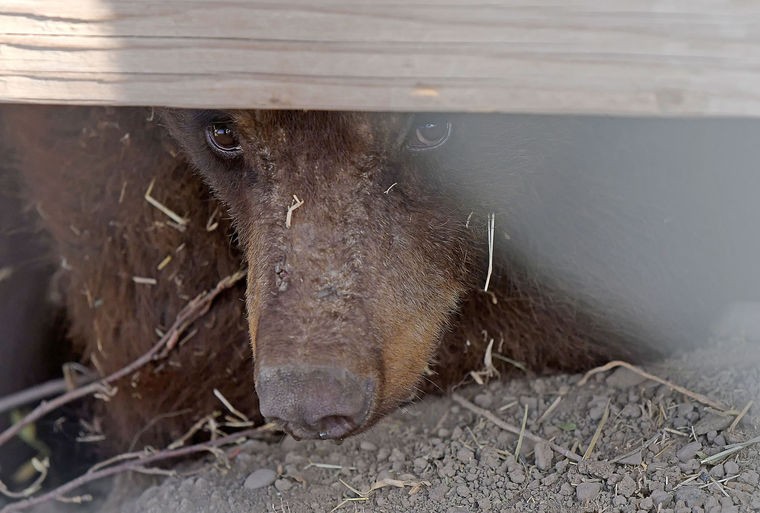A 30-pound fuzzy black ball of bear fur born early this spring made his debut on social media Monday before he was transported to the Predator Research Facility in Millville, where he will stay through the fall.
Utah Division of Wildlife Resources Game Mammals Coordinator Darren DeBloois said the bear cub was captured in Southern Utah on Sunday after the recent death of his mother.
Before his arrival in Millville, the cub was taken to the Salt Lake City offices where he was sedated and subjected to a complete physical exam and a round of antibiotics. He was a little dehydrated, so he was also given some fluids, but he otherwise appears to be in good health.
A video highlighting the process was filmed and posted on the DWR’s Facebook and Twitter pages, along with a link to a webcam set up in his pen so he can be viewed remotely: http://bit.ly/bear_cam.
Four years ago, a new set of pens was built at the Predator Research Facility to accommodate bears during a rehabilitation project.
The bears there on Wednesday — including the newcomer — are indicative of the scenarios that can bring bears to such a facility.
The oldest of the three was an unruly teenager who was causing some problems in Kamas, DeBloois said. The female is about 18 months old and while she wasn’t aggressive, she was a little too comfortable around humans, he said.
Because of her young age, wildlife experts believe she can be taught to be less social, so she was captured and brought to Millville where she is housed in an isolated pen with very limited human interaction.
Ordinarily, DeBloois said, every effort is made to release the bears in the area where they were found, but she will likely be transported to another more remote location so her affinity for humans isn’t tested.
The female is presently sharing a pen with a younger male cub who was also orphaned when his mother was killed. DeBloois believes he was also born this spring.
The other bears will be gradually introduced to one another over the next few days, and then they will live together until late October or early November.
Until then, DeBloois said the objective is to put some weight on each of them and make sure they are as healthy as possible before they are released into the wild.
During their stay, they are fed fruits and vegetables that are donated to the facility, some special pellets that are similar to dog food and a special formula packed with nutrition to help fatten them up for the winter.
In addition, they are offered protein whenever possible from fresh roadkill or fish from the fish hatcheries.
The food is left lying around the pen so the bears have to search for it, preparing them for a life in the wild, DeBloois said.
When the bears are fat and happy, wildlife officers will release them back into the wild after all of the hunts so they have less opportunity to encounter humans. A late-fall release also allows the bears to become acquainted with their new environment before they need to find a den and hunker down for the winter.
Each of the bears will be collared so biologists can track their movements, monitor how well they adjust to the wild and make sure they don’t get into trouble.
In July, two Utah bears were euthanized — one after repeatedly entering a Park City home and the other after biting the back of a man’s head while he lay sleeping.
DeBloois said there are bears in the Wasatch-Cache National Forest east of Logan, but they generally stay in the higher elevations between Monte Cristo and the Peter Sinks area.
The Predator Research Facility in Millville is operated by the USDA’s Animal and Plant Health Inspection Service in a close partnership with Utah State University.
The research facility houses about 100 coyotes on 165 acres of land located just south of Millville, and scientists there study the habits of predator mammals, with much of the research centered on coyotes.
According to the USDA, “research efforts are directed towards reducing livestock depredations and damage caused by coyotes, bears, and wolves, resolving conflicts in urban areas, and mitigating impacts of predators on wildlife populations.”



